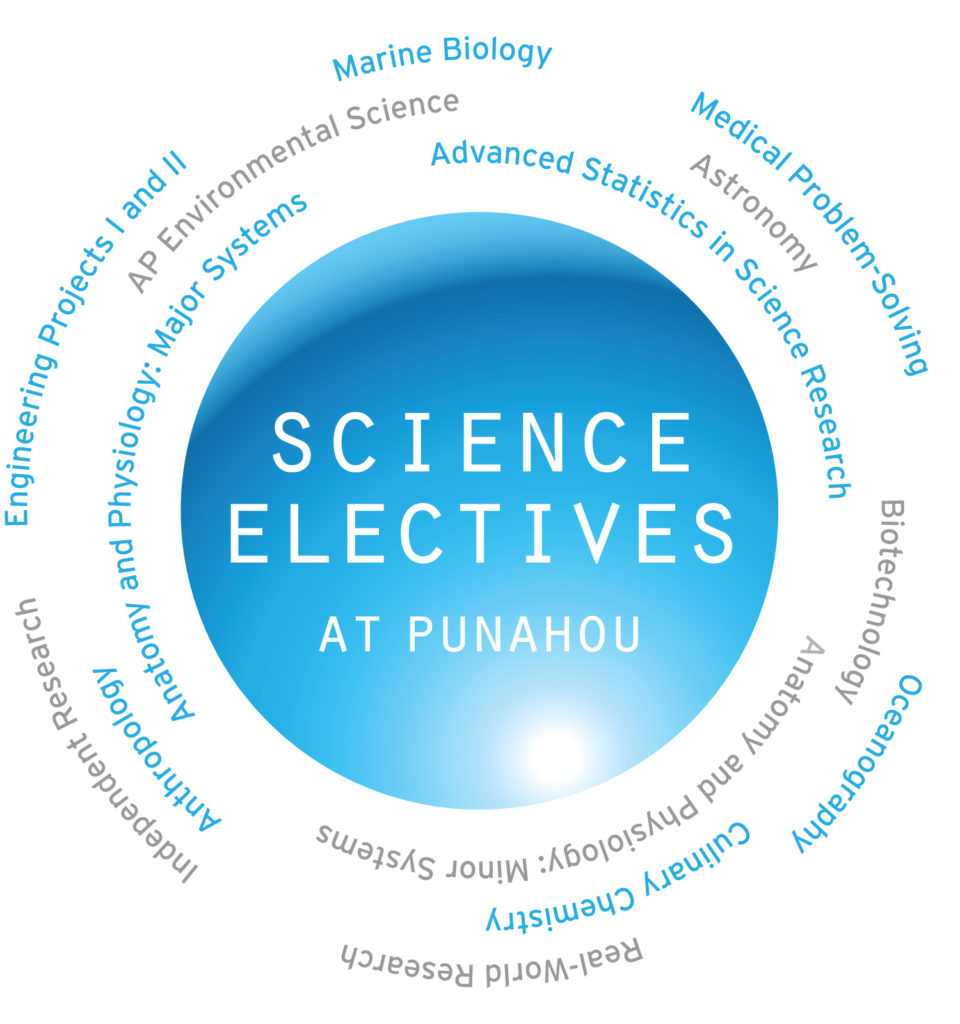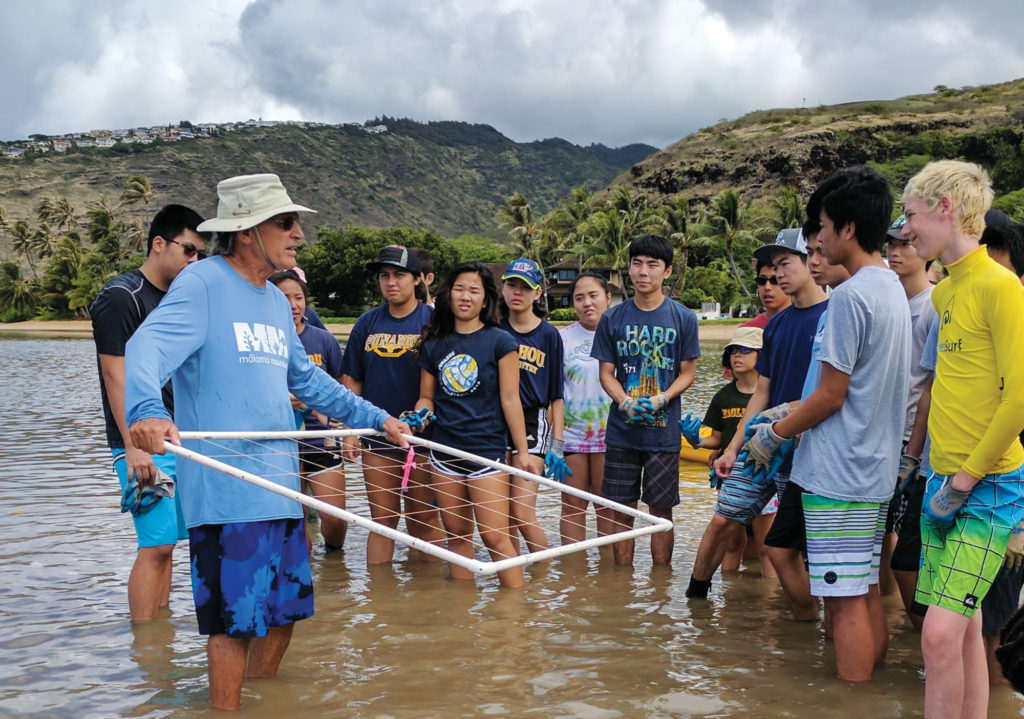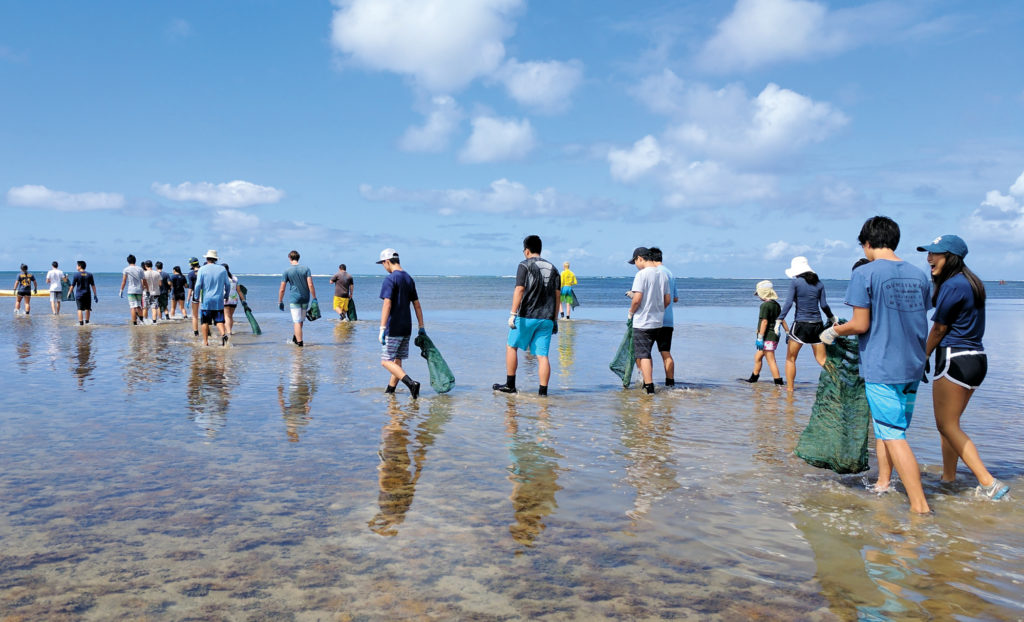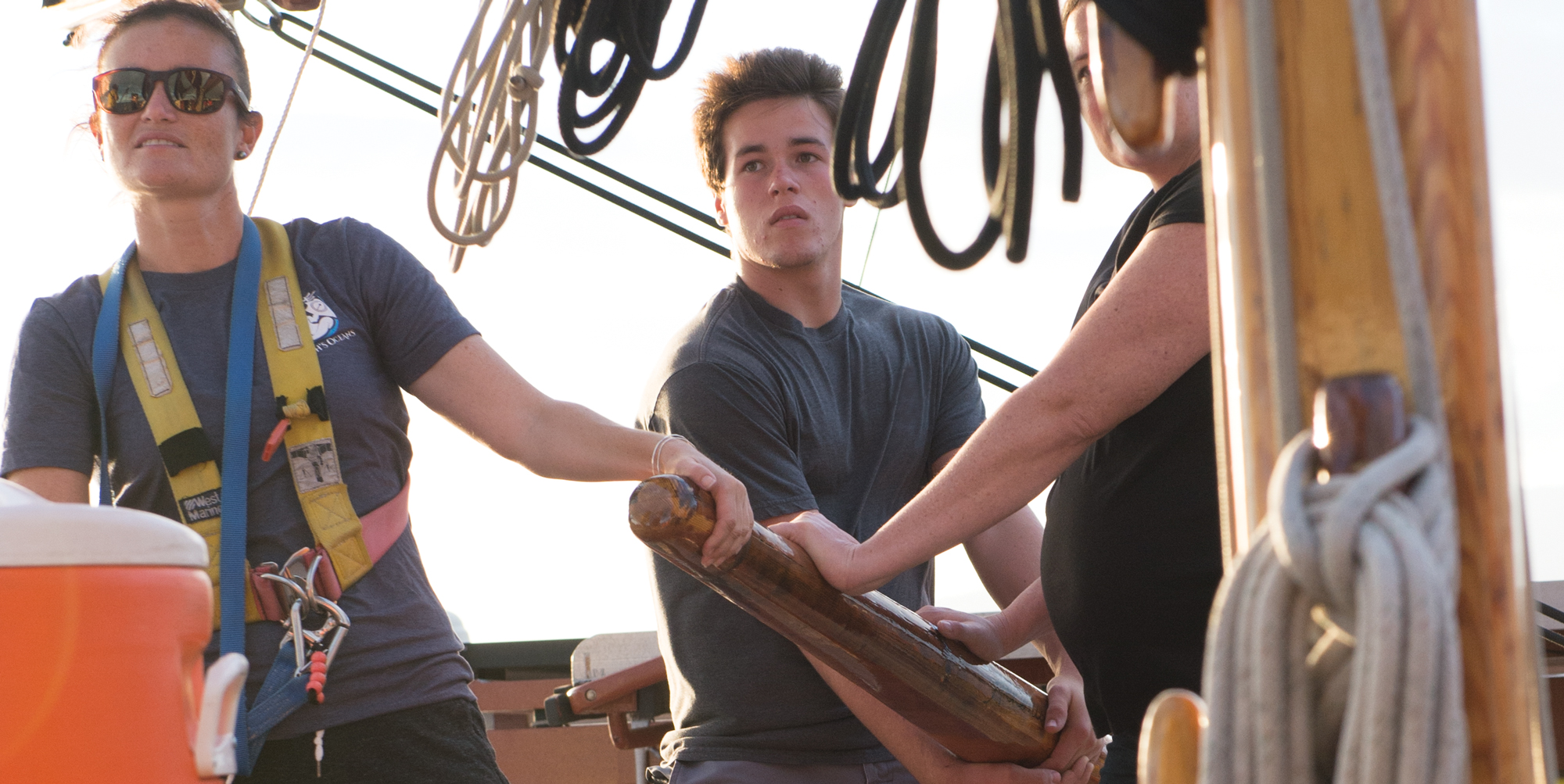By Camila Chaudron ’08
At Punahou, two credits of laboratory science are required to graduate, although most students choose to take three or four years of science – and those with a passion for the subject even opt to take five or six credits throughout their time in the Academy.
In addition to the classic sciences – biology, chemistry and physics, which are all offered at the regular, honors and AP levels – the Academy course catalog includes a long list of semester, year-long and summer electives for students to study what they are most passionate about.
Given the variety of options available to students, the opportunities for scientific exploration beyond the classroom are limitless.
Learning Can Happen Anywhere
A neuroscientist will tell you that learning happens in the brain, while a skilled educator will say that learning can happen anywhere – any place, any time. They’re both right, of course, although there are places, times and methods that optimize the neural re-networking called learning.
The Astronomy teachers in Punahou’s Science Department, for instance, know that talking and reading about the stars pale in comparison to seeing the celestial orbs in action the old-fashioned way, with a telescope at night. So, once a month, students conduct evening labs, affectionately termed Star Parties. “We have very strong telescopes,” says Academy Science teacher Adam Jenkins, “so students can mount their digital cameras onto them and take pictures of the moons of Jupiter or the rings of Saturn.”
Oceanography classes have similarly taken advantage of Hawai‘i’s resources to study the natural environment, whether through an excursion to Diamond Head lookout to help students better visualize their understanding of the way waves and tides work, or through a sunset sail aboard Hikianalia to learn how traditional navigation techniques require a thorough understanding of the ocean.
The point is that learning doesn’t just happen in the classroom. Punahou’s campus serves as a rich learning resource for students: Budding biologists study water turbidity in the Lily Pond; AP Environmental Science students learn about UV rays in the grassy area adjacent to Old School Hall; and young physicists learn about motion and momentum on the basketball courts. By taking advantage of varied spaces, students learn that science is everywhere.
Adaptable and Applicable
“When will I ever need to know this?” The courses offered through Punahou’s Science Department provide a clear response to this perennial question by teaching both content and important 21st-century skills like critical thinking, and by contextualizing the material in real-life scenarios.
“What we cover in class is super applicable,” says Claire Cutler ’18, who recently took AP Environmental Science. “I’ve actually gone home and changed the way I live – the things I’m eating, what I’m buying. My science class has actively influenced my day-to-day life.”
“Science offers the perfect mix of structure and flexibility,” says Austin Lau ’18, who is taking AP Physics C as a senior. “I like that there’s usually more than one way to get to an answer, and learning abstract concepts actually helps us understand the world better. In Physics, we learn about what actually goes on when you throw a ball.” Not only did he find the concepts “fascinating,” the process that underpins this seemingly simple act – an object in motion, traveling through space and time – is grounded in the real world.

While “discussion-based” might not be the first term that comes to mind with physics, “science allows students to have difficult conversations with less emotion,” explains Academy science faculty Tiffany Coke, who taught Capstone Science over the summer. Students applied the metacognitive processes of a scientist to ethical dilemmas.
“Being a critical thinker is about being a thoughtful and informed citizen,” Coke says, “and every science class pushes the importance of research and data.”
The process for determining the veracity of a claim or the reliability of a source is discussed across disciplines, but these ideas are clearly grasped in the sciences, where bias can more easily be determined quantitatively. Coke underscores the important role of teachers, who “require factual, well-organized thought processes.”
“Logic is not magic,” she notes, “information always comes from somewhere. The more students understand how to access the algorithms behind the data, the better.”
As part of Capstone, a graduation requirement with a service learning component, students are tasked with creating their own community project. In the science strand of Capstone, Coke emphasized data collection as an essential aspect of the project. Students had to compile data before beginning their work, demonstrating the validity, or societal need, of their project. “The idea,” she says, “is for students to engage in something that actually matters, to them and the people they intend to serve.”

Capstone Science students incorporated their experiences and interests into their projects: One student, who volunteered at Variety School, found that there was a need for theater classes. Acting had helped her overcome her shyness, so she understood the importance of offering performing arts education at a young age. She partnered with a classmate to devise lesson plans for teaching the students improv, and then they performed short improv shows together.
So, while it might be tempting to say that there was no science involved, every student had to record their work before, during and after, and then collect data on their impact. “This project really resonated with the students, so we wanted them to be able to show that they did something valuable,” says Coke. The best way to do that as scientists is “by using simple data collection and analysis.”
A Team Effort
Collaboration is as essential to the success of the Science Department a slight is to photosynthesis, so it makes sense that opportunities to work together are strategically woven into the structure of the department. Each sub-department meets one or more times a cycle to discuss the curriculum, or coordinate class projects and labs.
During the past academic year, while Coke was on sabbatical, Jenkins led the Astronomy class in her stead. Knowing that Jenkins had worked in the Navy and has many years of experience as a volunteer captain of the Hikianalia (the sister ship to Hokule‘a), Coke asked Jenkins to add a navigation unit to the curriculum. Through their collaboration, the longstanding class now has an added dimension. Jenkins was quick to point out that he has likewise borrowed and built upon ideas from his colleagues, whether it’s a lab unit devised by longtime Oceanography teacher Dave Strang or a method for tackling a physics concept from his officemate Jamey Clarke. “At Punahou,” says Jenkins, “we’re encouraged to experiment, to try new things.”

The result of this collaboration is that students learn to feel comfortable asking any teacher of their discipline for assistance. “It’s a very efficient use of resources,” says Coke, adding that she appreciates that “we’re able to help each other’s students.”
The teachers’ emphasis on collaboration engenders collaboration between students as well; peer tutors in particular recognize that learning and teaching are symbiotic experiences. Austin Lau ’18 began helping fellow students with Algebra and Chemistry in the Cooke Learning Commons in Cooke Library last year, part of a student-led tutoring project called “Learn How Now.”
When Lau went to tutor a topic that he hadn’t covered in several months, “it was a great test of whether or not I still had a grasp of the materials.” In helping others with the content, he was able to reinforce his understanding of the subjects.
Looking Ahead
Science Department Head Dan Gaudiano plans to keep innovating. “In speaking with recent alumni,” he says, “we’ve heard that they wanted more preparation with statistics and computer science, and more of the skills they needed in college and beyond.”
The next generation of students is coming up the ranks better versed in robotics, coding and engineering than ever before; they also are facing a world that is changing rapidly, where transferrable skills are key. “So we’re going to keep leaning into our teaching,” says Gaudiano: “When we work through questions that address real needs and problems, students are exposed to better and deeper opportunities for learning.”
Sustainable Progress
“There’s nothing abstract about where your water comes from,” notes Dan Gaudiano, Science department head and AP Environmental Science (APES) teacher. Every year, APES students learn about the resources that sustain their lives in concrete terms. When studying energy, they conduct an energy audit of campus: “They collect data on appliance use, classroom lighting, air conditioning, that sort of thing,” Gaudiano explains, “to see where we can save energy.”
The students then compile their data and make recommendations for the School. “The idea is to use energy more efficiently on campus, and we use our buildings as a case study,” Gaudiano explains. “When researching the air conditioning use in Pauahi Hall, they compare their data to national suggested temperatures, they question what it means for a room to be too cold, and also weigh in the personal health costs.”
The research has already come full circle: Recently, APES students were invited to share their findings at Punahou’s energy charrettes, part of the Net Zero Initiative, which aims to have the School function as an energy neutral campus – eventually giving back to the grid as much as it takes. Gaudiano also presented the students’ research to the architects for the developing Academy Learning Commons.
“Global warming, climate change, these are such big concepts, it can be overwhelming to think about,” says Isabelle Rhee ’18, a former APES student. Learning about concrete ways to make a difference motivated her to change her lifestyle.
Rhee appreciates that her science classes connect to contemporary issues, like the Paris Climate Agreement and the water pollution crisis highlighted in Flint, Michigan. Now, Rhee plans on leveraging her considerable talents as a writer – she’s the editor of the student paper, Ka Punahou – to publish a column on environmental issues like climate refugees. “Taking Environmental Science really broadened my perspective and understanding of the world,” she says.
Equipping Students for the Cutting Edge
Today’s Punahou students will graduate having had access to some of the most sophisticated engineering technology available, thanks in large part to the D. Kenneth Richardson ’48 Learning Lab. Located in the Gates Family Science Workshop, the new lab — set to open in the spring of 2018 — will be a space for interdisciplinary work, where students can design and create projects.
Students will be able to cut through heavy metal and plastic materials with water jet and laser cutters, reshape wood with computer numeric controlled machines and build objects using 3-D printers. All these tools will give students the chance to “amplify the complexity of their projects and their thinking,” says engineering teacher Justin Lai. He and fellow engineering colleague, Aaron Dengler, are spearheading the project.
The D. Kenneth Richardson ’48 Learning Lab will give students a space to “realize and iterate on an idea,” Dengler says, “making it more precise and refined – just as they would with an English essay – creating drafts and applying what they learn to future products.”

